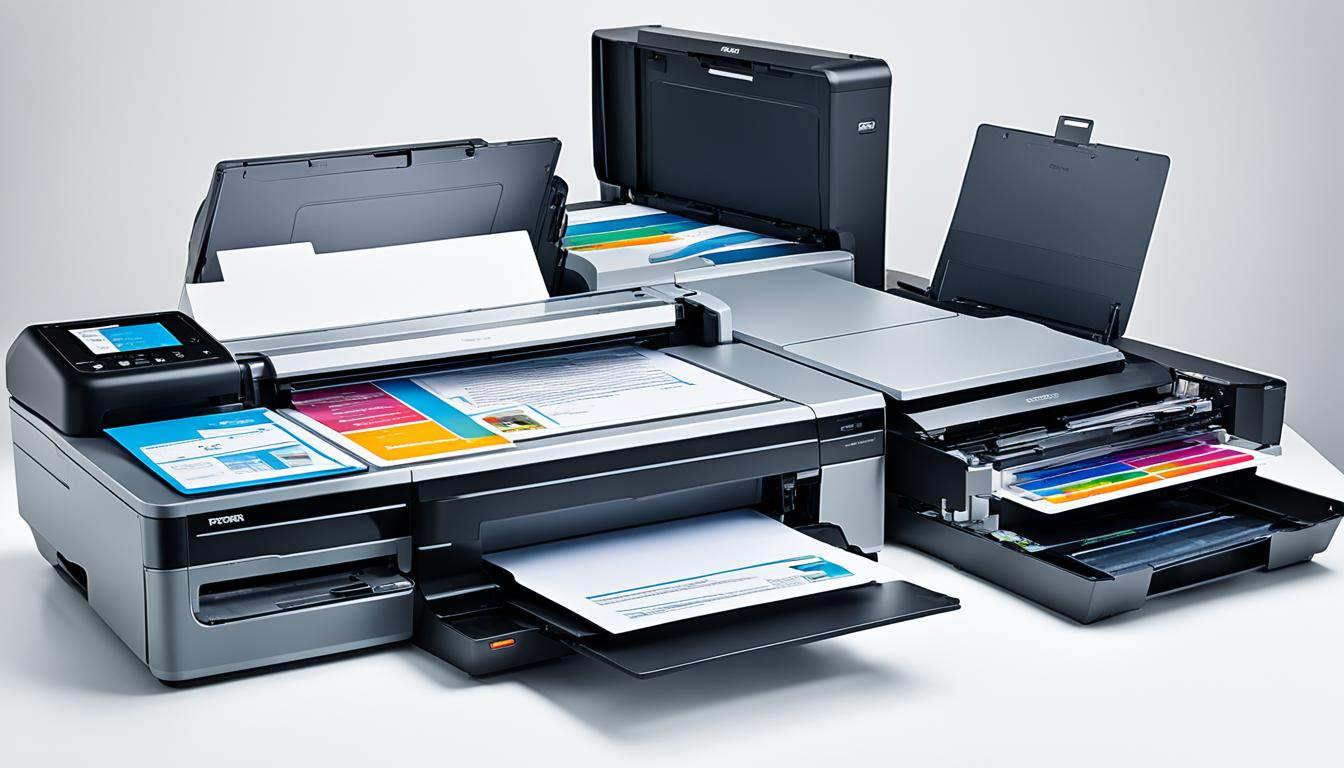When it comes to choosing the right multifunctional office equipment, understanding the capabilities of different printers is essential. While printers and scanners are often associated with each other, not all printers come equipped with a built-in scanner.
So, do all printers have a scanner? The answer is no. It is important to know the various types of printers available in the market and the features they offer before making a purchase decision.
Key Takeaways:
- Not all printers come with a built-in scanner.
- There are different types of printers available, including inkjet and laser printers.
- Multifunctional printers, also known as all-in-one printers, typically have a built-in scanner.
- Standalone scanners are dedicated devices for scanning documents.
- Consider your specific needs and preferences when shopping for printers or scanners.
Types of Printers
When it comes to printers, there are several different types available to suit various needs. The two most common types are inkjet printers and laser printers. While both inkjet printers and laser printers are widely used, it is important to note that not all printers within these categories come equipped with a built-in scanner.
Image:
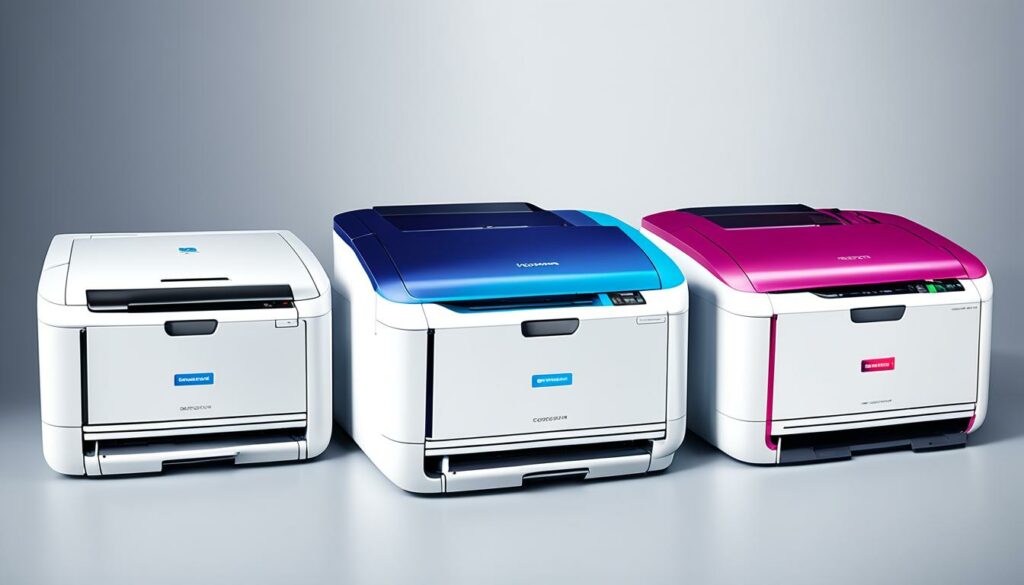
Table: Inkjet Printers vs. Laser Printers
| Type | Printing Technology | Scanning Capability |
|---|---|---|
| Inkjet Printers | Uses ink to produce images or text | Some inkjet printers may have scanning capabilities, but not all do |
| Laser Printers | Uses toner and a laser to produce high-quality prints | Some laser printers may have built-in scanners, but it is not a standard feature |
Inkjet printers work by spraying tiny droplets of ink onto the paper, resulting in vibrant colors and detailed prints. They are generally more affordable and suitable for home or small office use.
Laser printers, on the other hand, use a laser beam and toner to create prints. This printing technology offers faster speeds and more precise text and graphics. Laser printers are often used in larger offices or professional settings.
While some inkjet printers and laser printers have scanning capabilities, it is important to check the specifications when purchasing a printer if scanning is a requirement. Not all printers within these categories include a built-in scanner.
“Inkjet printers and laser printers offer different printing technologies, but not all of them come with scanners. Before purchasing a printer, it’s important to consider whether scanning capabilities are necessary.”
Multifunctional Printers
Multifunctional printers, also known as all-in-one printers, are versatile office equipment designed to handle multiple tasks efficiently. These printers combine the functionalities of a printer, scanner, copier, and sometimes even a fax machine in a single device, making them a convenient choice for various office environments.
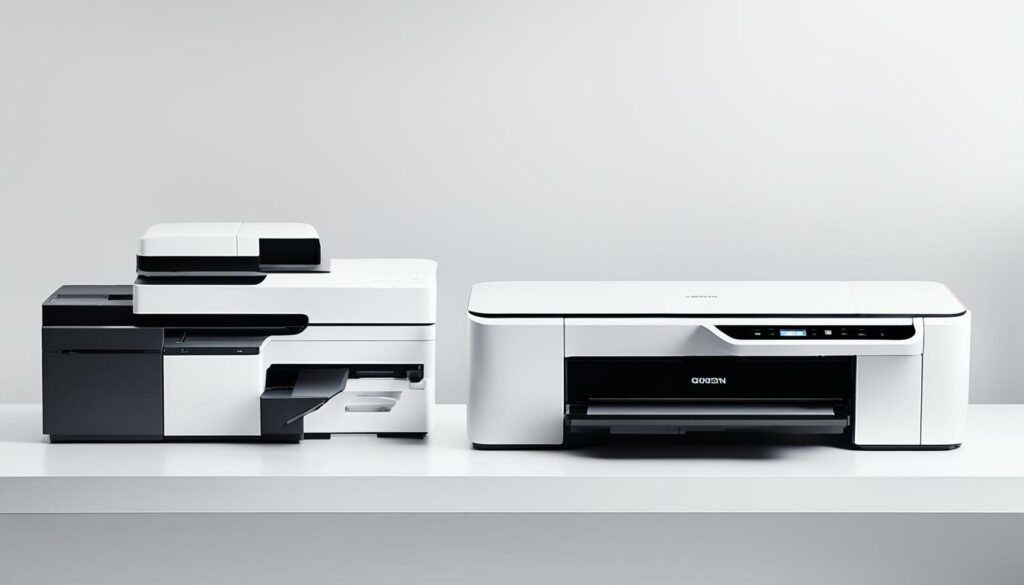
One of the key features of multifunctional printers is their built-in scanner. With a built-in scanner, these printers allow users to scan documents directly from the device without the need for a separate scanner. This eliminates the hassle of switching between different devices and saves valuable time and effort.
Multifunctional printers provide a comprehensive solution for all your office needs, from printing important documents to making digital copies and sending fax messages. With the integration of scanning capabilities, these printers offer a seamless workflow, enhancing productivity and efficiency in the workplace.
Benefits of Multifunctional Printers
Investing in a multifunctional printer offers several benefits:
- Space-saving: All-in-one printers eliminate the need for separate devices, saving valuable office space.
- Cost-effective: Instead of purchasing individual devices, a multifunctional printer provides multiple functionalities in one package, reducing overall equipment costs.
- Convenience: With a single device to handle various tasks, users can streamline their workflow and minimize interruptions.
- Time-saving: The integrated scanner allows for quick and efficient document scanning, eliminating the need for manual data entry and enhancing productivity.
Whether you need to print, scan, copy, or fax, a multifunctional printer offers a compact and efficient solution for all your office needs.
Comparison Table: Multifunctional Printers vs. Standalone Devices
To help you understand the key differences between multifunctional printers and standalone devices, the following table outlines some of their main features:
| Multifunctional Printers | Standalone Devices | |
|---|---|---|
| Functionality | Printing, scanning, copying, and sometimes faxing | Dedicated to a specific function (printing or scanning) |
| Space | Compact, all-in-one device | Requires separate devices |
| Cost | May be more cost-effective | Individual devices can be costly |
| Convenience | One device to handle multiple tasks | Device specialized for a specific function |
| Workflow | Streamlined and efficient | May require switching between devices |
As seen in the comparison table, multifunctional printers offer a comprehensive solution for various office needs and can significantly enhance productivity and efficiency.
Standalone Scanners
When it comes to document scanning, standalone scanners are the go-to devices. Designed exclusively for scanning, these devices offer high-resolution scanning options that are ideal for professional settings where precision and detail are crucial.
Unlike multifunctional printers, standalone scanners do not have printing capabilities. Their sole purpose is to capture and digitize documents, ensuring optimal image quality and clarity. This makes them a reliable choice for businesses that prioritize document digitization and archival.
Standalone scanners come equipped with advanced features that enhance the scanning process. They offer adjustable settings for resolution, color depth, and image enhancement, allowing users to tailor the scanning parameters to their specific needs. Additionally, these scanners often have automatic document feeders, enabling the quick scanning of multiple pages without constant supervision.
Whether it’s contracts, invoices, or important records, standalone scanners deliver exceptional results when it comes to capturing and preserving critical information. Their dedicated focus on scanning functionality ensures that every detail is accurately captured, making them indispensable tools in environments where high-quality scanning is paramount.
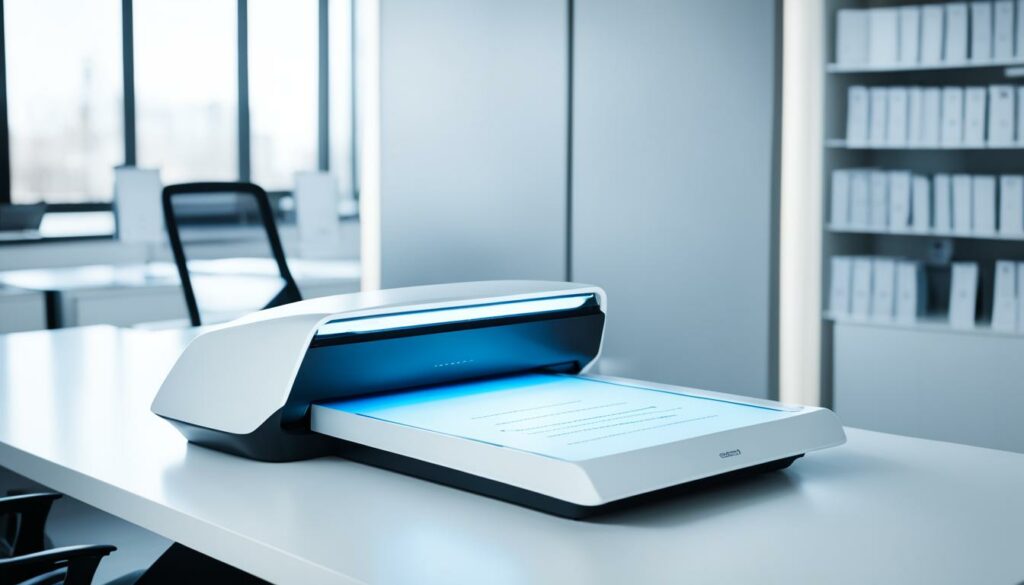
With standalone scanners, businesses can efficiently digitize their paper documents, creating searchable and easily accessible electronic files. This not only improves data organization but also enables faster information retrieval, saving time and improving overall productivity.
Furthermore, standalone scanners are compact and space-saving, allowing them to fit seamlessly into any office environment. Their small footprint and efficient design make them convenient additions to workstations or dedicated scanning areas.
“Standalone scanners provide professional-grade scanning capabilities, ensuring that every document is captured with the highest level of detail and accuracy.”
Whether in law firms, medical clinics, or other industries that rely heavily on document management and preservation, standalone scanners offer the reliability and precision needed to meet demanding scanning requirements.
In the next section, we will explore the different types of printers that do not come with built-in scanners, highlighting the options available for those who primarily require printing capabilities.
Printers Without Scanners
When it comes to printers, not all devices are equipped with built-in scanners. In fact, there are many printers available on the market that are designed solely for printing purposes and do not include scanning functionality.
These print-only devices are ideal for individuals or organizations that primarily need high-quality printing capabilities without the need for scanning documents. Whether you’re printing important business documents or vibrant color photographs, these printers deliver exceptional print quality and speed.
When purchasing a printer, it’s crucial to check the specifications to determine whether it includes a scanner or if it is a print-only device. Paying attention to these details ensures that you select the right printer to meet your specific needs and preferences.
Benefits of Printers Without Scanners
Printers without scanners offer several advantages:
- Cost-effective: Printers without scanners tend to be more affordable than multifunctional printers that include scanning capabilities.
- Space-saving: These sleek and compact devices require less space, making them suitable for smaller offices, home offices, or any environment where space is a premium.
- Specialized printing: Printers without scanners often excel in specific printing tasks, such as producing detailed graphics, professional brochures, or high-volume prints.
Whether you’re a professional photographer, graphic designer, or a small business owner in need of premium printing capabilities, investing in a printer without a scanner can be a cost-effective and space-saving solution.
“Printers without scanners provide targeted functionality with superior printing quality and efficiency. They are perfect for businesses or individuals who prioritize printing over scanning.”
Printer Models Without Scanners
| Printer Model | Printer Type | Key Features |
|---|---|---|
| Epson EcoTank ET-4760 | Inkjet Printer | Wireless, high-speed printing, large ink capacity for lower cost per page |
| HP LaserJet Pro M404dn | Laser Printer | Fast, professional-quality black and white printing, energy-efficient |
| Canon PIXMA TS9520 | Inkjet Printer | Wireless, versatile printing capabilities, supports borderless printing |
These are just a few examples of printers without scanners available in the market. Each model offers unique features and benefits to cater to different printing needs.
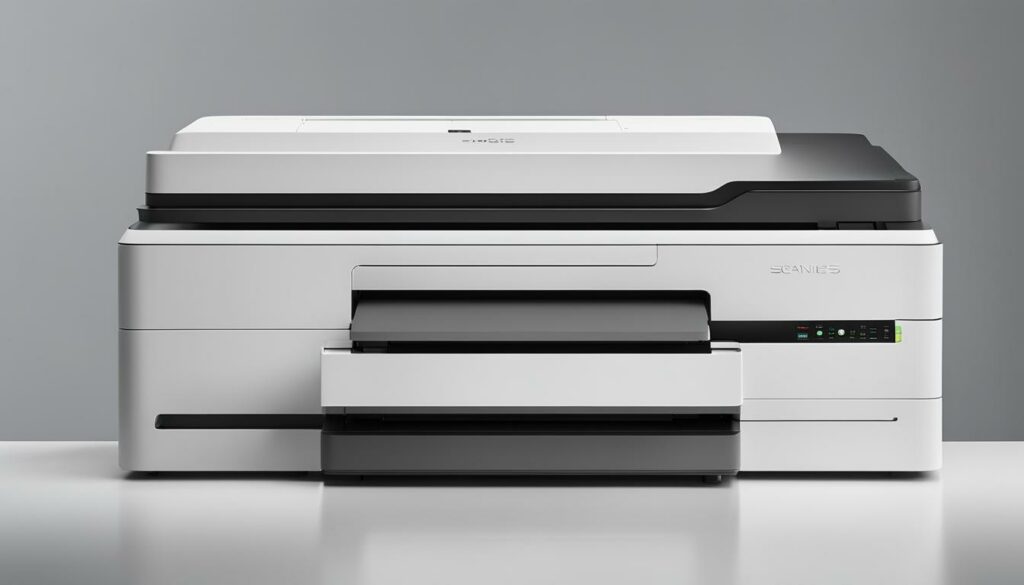
Overall, printers without scanners offer specialized printing capabilities, cost-effectiveness, and space-saving advantages. By understanding the options available, you can make an informed decision and select the right printer that meets your specific requirements.
Considerations When Shopping for Printers
When shopping for printers, it’s important to carefully consider the specific features and functionalities that align with your requirements. Whether you’re buying a printer for personal or professional use, understanding the different printer and scanner features will help you make an informed decision.
If scanning is a priority for your printing needs, look for printers that include a built-in scanner. These multifunctional printers offer the convenience of both printing and scanning capabilities in one device. They are ideal for offices or home setups where scanning documents is a frequent task. With a built-in scanner, you can easily digitize important documents, eliminating the need for a separate scanner.
If your printing needs primarily revolve around high-quality scanning, a standalone scanner might be a more suitable option. Standalone scanners are specifically designed for document scanning and offer advanced features such as high-resolution scanning and document feeders for speedy scanning of multiple pages. They are commonly used in professional settings where document digitization is a top priority.
Quote:
A multifunctional printer with a built-in scanner provides a convenient solution for those seeking both printing and scanning functionalities. On the other hand, standalone scanners offer unmatched scanning capabilities for professional document digitization needs.
When comparing printer and scanner features, consider factors such as scanning resolution, document feed capacity, duplex scanning capability, and software compatibility. These factors can greatly impact the efficiency and quality of your scanning tasks.
Printer Features to Consider:
- Printing speed
- Print quality (dpi)
- Paper handling capacity
- Wireless printing capabilities
- Color printing capabilities
Scanner Features to Consider:
- Scanning resolution (dpi)
- Automatic Document Feeder (ADF) capacity
- Duplex scanning
- Software compatibility
- OCR (Optical Character Recognition) functionality
By evaluating these printer and scanner features, you can ensure that your purchase aligns with your specific needs. Whether you opt for an all-in-one printer or a standalone scanner, investing in the right device will enhance your productivity and improve your printing and scanning experience.
| Printer Features | Scanner Features |
|---|---|
| Printing speed | Scanning resolution (dpi) |
| Print quality (dpi) | Automatic Document Feeder (ADF) capacity |
| Paper handling capacity | Duplex scanning |
| Wireless printing capabilities | Software compatibility |
| Color printing capabilities | OCR (Optical Character Recognition) functionality |
Remember to carefully review the specifications of each printer and scanner model to ensure it meets your specific requirements. By considering the features and functionalities offered by different devices, you can make an informed decision and find the printer or scanner that best suits your printing and scanning needs.
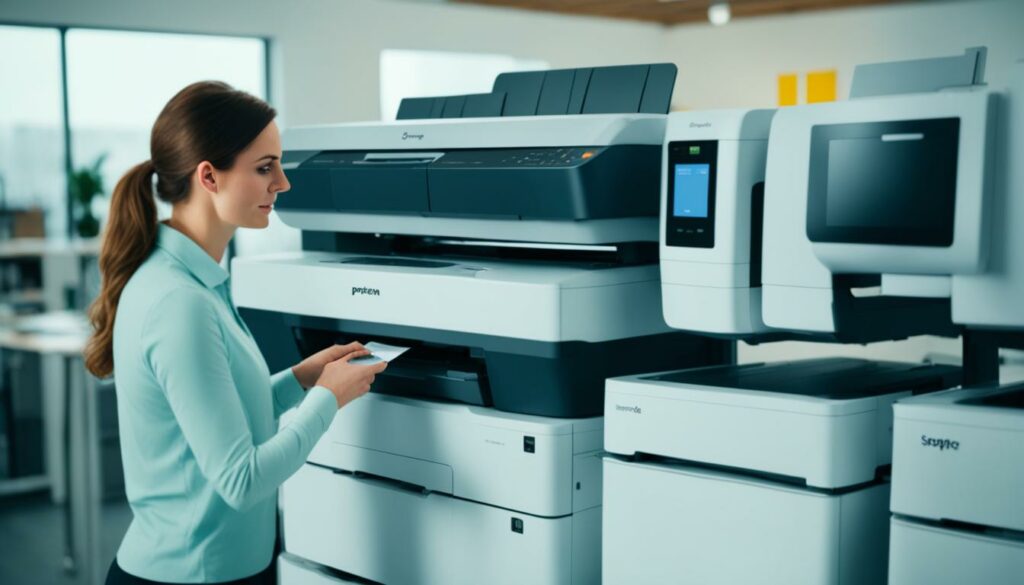
Benefits of All-in-One Printers
All-in-one printers offer several benefits that make them a practical choice for both home and office environments. One of the key advantages of all-in-one printers is their convenience. With a built-in scanner, these printers eliminate the need for a separate scanning device, allowing users to print and scan documents using a single multifunctional device.
Additionally, all-in-one printers are space-saving solutions. As they combine multiple functions in one compact device, they help save valuable office space. This is especially beneficial for small businesses or home offices where space may be limited.
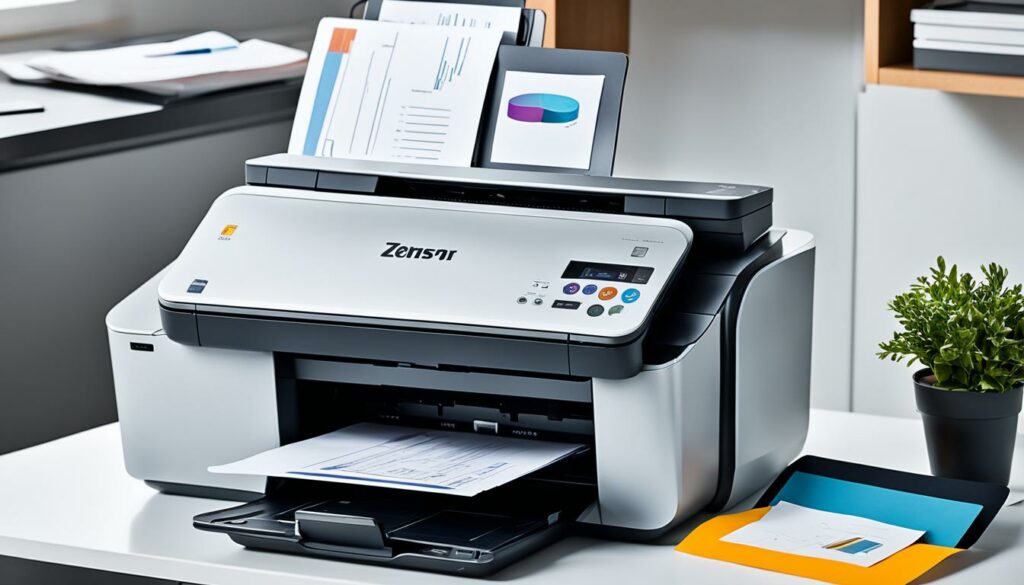
Whether you need to print, scan, copy, or even fax documents, all-in-one printers provide a convenient and space-efficient solution. They offer versatility, efficiency, and cost-effectiveness, making them an ideal choice for those in need of a multifunctional printer.
Standalone Scanners vs. All-in-One Printers
When it comes to scanning documents, choosing between standalone scanners and all-in-one printers can be a tough decision. Both options offer unique benefits, and the right choice depends on your specific scanning needs and preferences.
Standalone Scanners: Unmatched Scanning Quality
Standalone scanners are dedicated devices designed solely for scanning documents. They are often preferred by professionals who require high-quality scans with precise details. These scanners offer advanced scanning features, including high-resolution capabilities and specialized software for image correction and enhancement. With standalone scanners, you can be confident that every document you scan will be captured with exceptional clarity and accuracy.
All-in-One Printers: Convenience at Your Fingertips
All-in-one printers, also known as multifunction printers, combine the functionalities of printing, scanning, copying, and sometimes faxing into a single device. These versatile machines offer the convenience of handling multiple tasks without the need for separate devices. While the scanning quality may not match that of standalone scanners, all-in-one printers provide a practical solution for those who require occasional scanning alongside their printing needs. These devices are particularly beneficial in small office spaces where efficiency and space-saving are crucial considerations.
To help you understand the key differences between standalone scanners and all-in-one printers, here’s a comparative overview:
| Scanning Quality | Convenience |
|---|---|
| Standalone Scanners | All-in-One Printers |
| Offers unmatched scanning quality with high-resolution capabilities and advanced image correction software. | Provides convenience with the ability to perform multiple functions in one device, albeit with slightly lower scanning quality compared to standalone scanners. |
Ultimately, the choice between standalone scanners and all-in-one printers depends on your priorities. If scanning quality and precision are of utmost importance, a standalone scanner is your best bet. However, if you value convenience and the ability to handle multiple tasks with a single device, an all-in-one printer is the way to go.

Remember, when considering the scanning quality and capabilities of any device, it’s important to thoroughly research and compare different models and brands. This will ensure you make an informed decision and find the perfect solution that meets your scanning needs.
Printing and Scanning Solutions for Different Needs
The choice between standalone scanners and all-in-one printers depends on the specific needs of the user. In professional settings, standalone scanners are favored for their advanced scanning capabilities, while all-in-one printers are more suitable for versatile printing and occasional scanning needs at home.
Standalone scanners are specifically designed for document scanning, offering high-resolution digitization options. They are commonly used in professional settings where accurate and detailed scanning is crucial, such as law firms, design studios, and medical offices.
On the other hand, all-in-one printers provide a convenient solution for home users who prioritize printing and occasional scanning. These multifunction devices combine the capabilities of a printer, scanner, copier, and sometimes even a fax machine, making them a versatile choice for various home office tasks.
Not only do all-in-one printers save space, but they also offer a cost-effective solution by eliminating the need for separate devices. They are user-friendly and designed with features that cater to the needs of home users, such as wireless connectivity and intuitive controls.
Comparison of Standalone Scanners and All-in-One Printers:
| Feature | Standalone Scanners | All-in-One Printers |
|---|---|---|
| Scanning Quality | High-resolution scanning for professional use | Good quality for home and occasional use |
| Functionality | Dedicated scanning device | Multiple functions in one device (printing, scanning, copying, sometimes faxing) |
| Cost | Higher upfront cost for advanced scanning capabilities | Value for money with combined printing and scanning capabilities |
| Space | Requires additional space for separate device | Compact and space-saving |
| User-Friendliness | Straightforward scanning operation | Intuitive controls and wireless connectivity options |
Ultimately, the decision between standalone scanners and all-in-one printers relies on individual preferences and intended usage. Consider the specific needs of your professional setting or home office to determine whether advanced scanning capabilities or multifunctionality would be more beneficial.
“The choice between standalone scanners and all-in-one printers should be based on the user’s specific needs and preferences. While standalone scanners are ideal for professional settings that prioritize advanced scanning capabilities, all-in-one printers offer convenience and versatility for home users.”
By understanding the differences between these two printing and scanning solutions, you can make an informed decision that aligns with your needs and maximizes productivity.
Privacy Concerns and Tracking Technology
In today’s digital age, where data privacy is a growing concern, printer tracking technology has become a topic of interest. Some printers, especially color laser printers, incorporate a covert feature known as tracking dots into printed documents. These tracking dots, invisible to the naked eye, contain information about the printer’s serial number and the date and time the document was printed.
This printer tracking technology has raised privacy concerns among individuals and organizations. The potential for misuse of this technology, such as tracking or identifying individuals based on printed documents, has sparked debates regarding the balance between security and privacy.
| Privacy Concerns | Tracking Dots |
|---|---|
| 1. Tracking Individuals: | Tracking dots can be used to trace documents back to specific individuals or organizations, potentially infringing on privacy rights. |
| 2. Data Security: | The information contained in tracking dots may be vulnerable to unauthorized access, raising concerns about data security. |
| 3. Surveillance Potential: | Government agencies or other entities could potentially exploit printer tracking technology for surveillance purposes, further challenging privacy rights. |
It is important for individuals and organizations to be aware of these privacy concerns when using printers that utilize tracking dots. Taking proactive steps to safeguard sensitive information and understand the implications of using such printers is crucial in today’s technology-driven world.
While printer tracking technology can be viewed as a privacy trade-off, it is worth noting that not all printers include this feature. When purchasing a printer, individuals and organizations can inquire about the presence of tracking dots and make informed decisions based on their privacy preferences.
As the discussion surrounding privacy concerns and tracking technology continues, it is essential for individuals, regulators, and manufacturers to work together to find a balance that respects privacy rights while ensuring the necessary security measures are in place.
Legal Implications and Regulations
While printers and scanners offer convenience and productivity, the use of tracking dots by the government for surveillance purposes raises legal and ethical questions. Currently, there are no specific laws or regulations in the US that mandate the inclusion of tracking dots in printers.
However, it is crucial to be aware of the potential implications of this technology. Tracking dots embedded in printed documents can disclose information such as the printer’s serial number and the date and time the document was printed. These dots represent a form of government surveillance that can infringe on privacy rights.
“The use of tracking dots by the government for surveillance purposes without explicit regulations raises concerns regarding privacy and individual rights.” – [Expert Name]
As the technology advances and the debate around privacy intensifies, it is essential for legislation to address these concerns. Striking the right balance between security measures and individual privacy is crucial in safeguarding the rights of citizens.
| Legal Implications | Regulations | Government Surveillance |
|---|---|---|
| Concerns about privacy rights | No specific laws mandating tracking dots | Tracking dots as a form of surveillance |
| Debate on the impact of tracking technology | Legal framework needed to address privacy concerns | Balancing security measures and individual rights |
As individuals and organizations become more aware of the legal implications of tracking dots, it becomes increasingly important to advocate for clear regulations that outline the boundaries of government surveillance. Safeguarding privacy rights is crucial in ensuring a balanced and transparent approach to national security.
Protecting Privacy in the Digital Age
In an era where technology advances rapidly, policymakers and legislators face the challenge of appropriately regulating the use of tracking technology. Balancing national security needs with individual privacy rights requires careful consideration and a comprehensive legal framework that safeguards citizens’ fundamental rights.
Conclusion
In conclusion, when it comes to printers, not all devices come equipped with a scanner. While some printers, such as all-in-one printers, offer the convenience of both printing and scanning functionalities, there are standalone scanners available for those who require high-quality scanning capabilities. It is crucial to consider your specific needs and preferences to make an informed decision when selecting a printer or scanner device.
For those looking for a versatile solution that combines printing and scanning functions, all-in-one printers can be a practical choice. These devices offer convenience and space-saving benefits, eliminating the need for a separate scanner. However, if scanning documents with exceptional quality is a priority, standalone scanners are designed specifically for this purpose and may be more suitable.
Ultimately, the choice between a printer with a built-in scanner or a standalone scanner depends on individual requirements. Professionals who prioritize high-resolution scanning for their document digitization needs may benefit from investing in standalone scanners. On the other hand, home users or small office environments may find all-in-one printers to be a cost-effective and efficient solution for their printing and occasional scanning tasks.

Morgan Azhari, the owner of PrinterUpdate.net, is a dedicated expert in the field of printers, leveraging a wealth of experience and education to create a platform that passionately shares insights and solutions.
With a goal to enhance the printer user experience, my vision for the website is to provide valuable content, making a positive impact on individuals navigating the complexities of printers.
